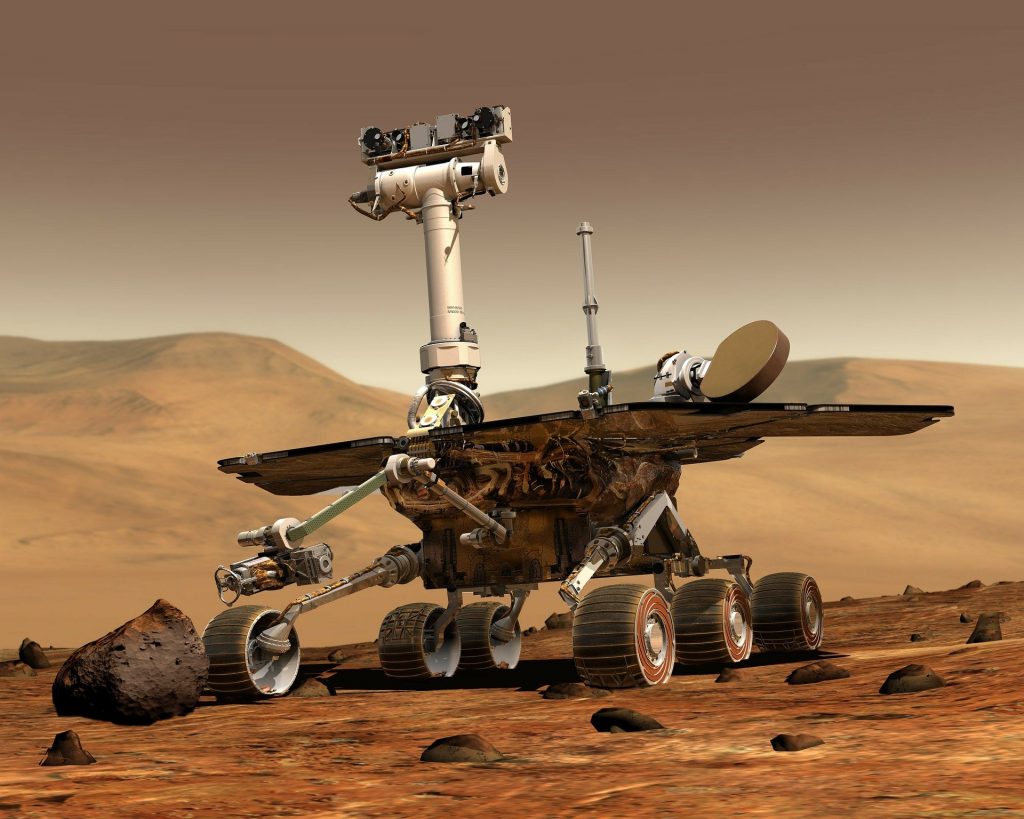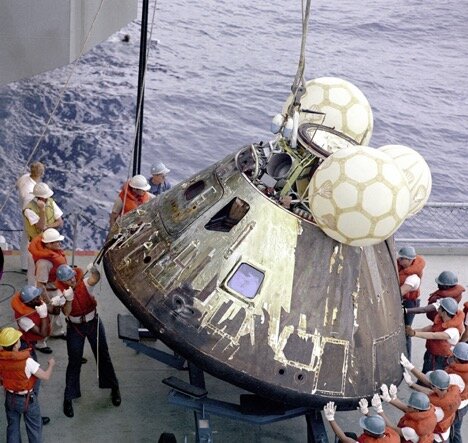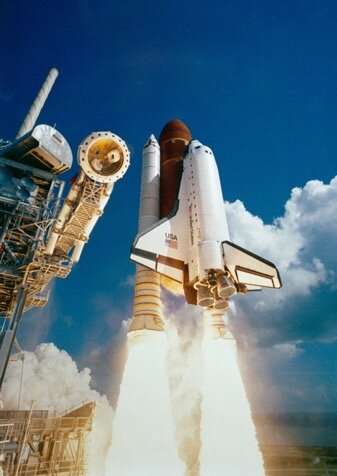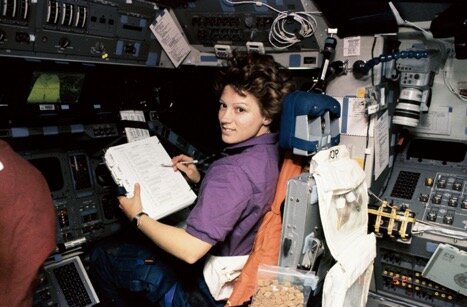Imagining Our Future in Space: NASA’s Sociotechnical Imaginary
Michael Stuart

This blogpost presents some thoughts I’ve been having while writing a paper together with Jamie Shaw.)
Imagining humanity’s future in space can be exhilarating. But it’s also big business. NASA, SpaceX, Blue Origin, Virgin Galactic, and the whole sci-fi industry shape and are shaped by what we imagine. Whether we grow up wanting to be astronauts, cosmonauts, taikonauts, spationauts, or some other kind of “naut” depends on what we imagine. Do we see such people as superheroes, cowboys, scientists, celebrities, or public funds poorly invested? In fields like science and technology studies, such collective imaginings related to on-going and future scientific and technological projects are referred to as “sociotechnical imaginaries.”
Focusing on the case of NASA, I want to think about these imaginaries and what they have to do with imagination. Specifically, three questions stand out: (1) What is imagined in a sociotechnical imaginary? (2) Who decides the imaginative content of an imaginary? And (3), can imaginaries be democratized?
1. What is imagined in an imaginary?
The “sociotechnical imaginary” is a concept that was proposed by science and technology scholars Sheila Jasanoff and Sang-Hyun Kim as “collectively imagined forms of social life and social order” that play a role in national scientific-technological projects (Jasanoff and Kim 2009, 120).[1] As Sergio Sismondo (2020) notes, sociotechnical imaginaries need to be somewhat stable, so we should expect imaginaries to have something like a solid core that is maintained over time. For NASA, this core goes back (at least) to space popularizer Werner von Braun’s 1950s vision of the future. Here, orbiting space stations facilitate exploratory expeditions to the moon and Mars, eventually followed by civilians who establish a permanent extraterrestrial presence (McCurdy 1997). All of this can still be found in NASA’s current long-term plan. NASA’s core imaginary revolves around a vision like this, along with a set of values. It seems to me that these can exist (for awhile, anyway) even when no one is currently imagining a future in which those goals are realized. The role of imagination in a sociotechnical imaginary might therefore be more like working in a company with strong branding than playing Dungeons and Dragons. Still, the existence of a sociotechnical imaginary requires some “collective imagining.” Can we say more about this?
Drawing on the work of Elisabeth Camp, I’m inclined to think that imaginaries are not thoughts, but ways of thinking. Instead of being a list of things that people imagine, imaginaries are cognitively powerful packages, easy to unpack, which dispose us to judge, imagine, feel, and act in certain ways (Camp 2006; 2009; 2020). This idea allows us to identify imaginaries relatively easily as they are expressed in speeches, commercials, funding choices and art, while at the same time allowing for a good deal of personal leeway in the actual acts of imagination involved. For example, participating in an imaginary where space is portrayed as a “new frontier” might cause person A to imagine space as a dangerous and lawless place where the brave can find fame and fortune, while person B imagines corporations greedily exploiting labourers and ignoring environmental issues (Messeri 2017).[2] In other words, while the space-as-frontier imaginary is relatively specific, what we actually imagine when interacting with it will depend on our previous experiences, values, culture, and much else.
On this view, then, a sociotechnical imaginary frames the present in terms of the future, in a way that smuggles in commitments about what to imagine when we think about the future, encouraging us to value (positive or negatively) a future like that. Also, actively imagining the future is just one part of a much larger set of things that we are disposed to do when participating in an imaginary (like judge, feel, value, act), although it’s still an important if not central part. Finally, while our values, experiences, culture (etc.) will shape our imaginings, those influences won’t always be taken into account by those who have the power to shift the imaginary.
2. Who is in control?
Sometimes technocrats will define an imaginary and impose it on others. For example, in the 1950s, the public image of nuclear power in the US was coloured by the horrors of Hiroshima and Nagasaki. Walt Disney tried to soften the American nuclear imaginary with a book and animated film called “Our Friend the Atom” (Haber 1956). To do this, Disney insisted on using slick aesthetic designs, narrative, and other tricks of the rhetorical trade (Disney 1954; Langer 1995; Mechling and Mechling 1995). NASA’s early relationship to its imaginary looks similar. During the Mercury, Gemini and Apollo eras, there was a concerted effort to portray America’s space imaginary as vital to national security. As NASA administrator James Webb wrote in Time magazine, “it is essential that other nations believe that we have the capability and determination to carry out whatever we declare seriously that we intend to do. Space achievements have become today’s symbols of tomorrow’s scientific and technical supremacy in the minds of millions of the world’s people” (Webb 1961). In Life magazine, President Kennedy portrayed NASA’s goals in a less militaristic light by painting astronauts as Americans with “the right stuff” (Garber 2013), and in his famous “We choose to go to the Moon” speech, he framed space exploration as a goal to be pursued simply because it was difficult. In each of these cases, we see power being used to shape the imaginary.
However, if a national sociotechnical imaginary is to survive in a democracy there must be public support. We should therefore expect organizations like NASA to update their branding in response to social and cultural changes. And indeed, it has. For example, one important historical shift (highlighted by Kaminski 2015) took place roughly a decade after Apollo. At that time, NASA revamped its image with the Space Shuttle program. Space travel would no longer be a group of white military men stoically whizzing around in capsules, but a diverse set of citizens sitting in an actual driver’s seat (even if almost all of the “driving” was still done remotely and automatically). The reusable Shuttle had the face of an environmentally friendly, utilitarian workhorse, that could transport ordinary citizens to the stars. NASA encouraged this new imaginary in a series of public outreach and education campaigns, including media relations, new public facilities and televised Shuttle launches. You can see the difference by comparing figures 1 and 2 with 3 and 4.




There are ways for the public to have an even more direct influence on the US space imaginary, and NASA recently opened up to this. In 2014, NASA enlisted the Expert and Citizen Assessment of Science and Technology (ECAST) network to create forums in Phoenix and Boston, with 186 ordinary citizens carefully selected to ensure a representative sample. Participants were provided with background reading about future options for space exploration, resource extraction, planetary defense, and the colonization of Mars. Participants discussed these topics in small groups and expressed their preferences by vote. Deliberations were recorded, transcribed, analyzed and presented to NASA (see Tomblin et al. 2017; Tomblin et al. 2015; Bertrand, Pirtle, and Tomblin 2017).
3. Can imaginaries be democratized?
The above endeavour was an experiment to find out how everyday people imagine humanity’s future relationship with space, and to see if this could inform NASA’s space imaginary going forward. It therefore looks like progress towards a more democratized space imaginary, especially since the results influenced decisions that were made at NASA. Insofar as democratizing imaginaries is valuable, this kind of work is valuable.
Of course, there are methodological difficulties that will vex any attempt like this. It is always difficult to say what participants are actually imagining at any given time, or why, or what they would have imagined under slightly different circumstances. NASA and ECAST could only present so many options for discussion, and their exclusion of certain topics inevitably constrained participant imagination. Nevertheless, participants did imagine in impressive and unexpected ways. (We know this because the people at NASA and ECAST were kind enough to make their data available to us). Again, and unavoidably, most of these rich imaginative episodes were “flattened” by the use of voting, by people talking over one another or ignoring each other, and by time limitations. There were some occasions where a person would inspire their discussion group to imagine a future scenario in a novel way, which would change the group’s mind about what NASA should do in some future scenario, resulting in the participants refusing to vote for one of the given options, and instead writing down their own option (which was something they were encouraged to do). But such choices were categorized in the quantitative analysis as votes for “other options.” This meant that even very impactful group imaginings would be invisible to higher-ups who only looked at the quantitative results. And when some of the imaginative episodes were singled out and emphasized in the qualitative report, they weren’t always taken seriously by officials at NASA. And for whatever reason, no further studies of this kind have been undertaken since.
More generally, it’s not even clear whether an ideal sociological intervention could help. Suppose we knew what every citizen imagined the future to be like. This might count out certain imaginaries as democratic, but it would not be enough to select one as the people’s choice. This is because, given an imagining, it is very difficult to infer “the” frame which did (or would have best) produced it. For example, imagining space as being lonely is consistent with a very large number of imaginaries. A related problem is that agreement between imaginings does not imply value-alignment. Everyone could imagine life in space in the very same way, for example, but the mere fact of unanimity doesn’t imply that such an imagined future is desirable for those who imagined it. What we really need, it seems, is information about people’s authentic future-directed imaginings, that is, imaginings that exemplify an individual’s core values.[3] Focusing on values, however, suggests that the imaginings themselves don’t matter that much. Can that be right?
The concept of the sociotechnical imaginary is used in many different disciplines, including science and technology studies, anthropology, philosophy, sociology, history, and international relations. If imagination is at the centre of all this, we who study imagination could be very useful. But it’s just not clear how much imagination is in the imaginary, or what it’s doing in there.
Jamie Shaw and I would like to thank Zachary Pirtle from NASA and David Tomblin and Mahmud Farooque from ECAST for their help and encouragement.
(From THE JUNKYARD)
Notes
[1] Though talking about things as “imaginaries” goes back at least to the 1950s (Morris and Nerlich 2015).
[2] Here is another example I like but which didn’t quite catch on: NASA’s “H-metaphor” was the idea of framing autonomous exploration vehicles as horses (Flemisch et al. 2003), which can perceive, respond to, and navigate difficult terrain by themselves, can be trained (and re-trained), and are responsive to human input.
[3] “Authentic imagination” is not something discussed often in Western philosophy of imagination, but it does come up in Chinese discussions of imagination. See, e.g., Lynn (2019).
References:
Bertrand, Pierre, Zachary Pirtle, and David Tomblin. 2017. “Participatory Technology Assessment for Mars Mission Planning: Public Values and Rationales.” Space Policy 42: 41–53. https://doi.org/10.1016/j.spacepol.2017.08.004.
Camp, Elisabeth. 2006. “Metaphor and That Certain ‘Je Ne Sais Quoi.’” Philosophical Studies 129: 1–25.
———. 2009. “Two Varieties of Literary Imagination: Metaphor, Fiction, and Thought Experiments.” Midwest Studies in Philosophy 33 (1): 107–30.
———. 2020. “Imaginative Frames for Scientific Inquiry: Metaphors, Telling Facts, and Just-So Stories.” In The Scientific Imagination, edited by P. Godfrey-Smith and A. Levy. Oxford: Oxford University Press.
Disney, Walt. 1954. “Educational Values in Factual Nature Pictures.” Educational Horizons 33 (2): 82–84.
Flemisch, Frank, Catherine Adams, Sheila Conway, Ken Goodrich, Michael Palmer, and Paul Schutte. 2003. “The H-Metaphor as a Guideline for Vehicle Automation and Interaction.” NASA TM-2003-212672. NASA Langley Research Center.
Garber, Megan. 2013. “Astro Mad Men: NASA’s 1960s Campaign to Win America’s Heart.” The Atlantic, July 31, 2013. https://www.theatlantic.com/technology/archive/2013/07/astro-mad-men-nasas-1960s-campaign-to-win-americas-heart/278233/.
Haber, Heinz. 1956. The Walt Disney Story of Our Friend the Atom. New York: Simon and Schuster.
Kaminski, Amy Paige. 2015. “Sharing the Shuttle with America: NASA and Public Engagement after Apollo,” Thesis. https://vtechworks.lib.vt.edu/handle/10919/79365.
Langer, Mark. 1995. “Why the Atom Is Our Friend: Disney, General Dynamics and the USS Nautilus.” Art History 18 (1): 63–96. https://doi.org/10.1111/j.1467-8365.1995.tb00609.x.
Lynn, Richard John. 2019. “Truth and Imagination in China Opposition and Conciliation.” In Imagination: Cross-Cultural Philosophical Analyses, Ed.Han-Georg Moeller and Andrew K. Whitehead. New York and London: Bloomsbury, Pp. 13-27., edited by Hans-Georg Moeller and Andrew K. Whitehead, 13–27. New York: Bloomsbury.
McCurdy, Howard E. 1997. Space and the American Imagination. Washington: Smithsonian Institution Press.
Mechling, Elizabeth Walker, and Jay Mechling. 1995. “The Atom According to Disney.” Quarterly Journal of Speech 81 (4): 436–53. https://doi.org/10.1080/00335639509384128.
Messeri, Lisa. 2017. “Why We Need to Stop Talking About Space as a ‘Frontier.’” Slate Magazine: Future Tense, 2017. https://slate.com/technology/2017/03/why-we-need-to-stop-talking-about-space-as-a-frontier.html.
Morris, Carol, and Brigitte Nerlich. 2015. “Imagining Imaginaries.” University of Nottingham Blogs: Making Science Public (blog). 2015. https://blogs.nottingham.ac.uk/makingsciencepublic/2015/04/23/imagining-imaginaries/.
Tomblin, David, Zachary Pirtle, Mahmud Farooque, David Sittenfeld, Erin Mahoney, Rick Worthington, Gretchen Gano, et al. 2017. “Integrating Public Deliberation into Engineering Systems: Participatory Technology Assessment of NASA’s Asteroid Redirect Mission.” Astropolitics 15 (2): 141–66. https://doi.org/10.1080/14777622.2017.1340823.
Tomblin, David, R Worthington, G Gano, M Farooque, D Sittenfeld, and J Lloyd. 2015. “Informing NASA’s Asteroid Initiative: A Citizen’s Forum.”
Webb, James E. 1961. “America’s Role In Space Today; Head of United States Space Agency Gives Five Reasons Why This Country Must Move to Master Space Flight U.S. Role In Space Head of Space Agency Reviews Progress.” The New York Times, October 8, 1961, sec. Archives. https://www.nytimes.com/1961/10/08/archives/americas-role-in-space-today-head-of-united-states-space-agency.html.
Arcangeli, Margherita. 2010. “Imagination in Thought Experimentation: Sketching a Cognitive Approach to Thought Experiments.” In Model-Based Reasoning in Science and Technology: Abduction, Logic, and Computational Discovery, edited by Lorenzo Magnani, Walter Carnielli, and Claudio Pizzi, 571–87. Studies in Computational Intelligence. Berlin, Heidelberg: Springer. https://doi.org/10.1007/978-3-642-15223-8_32.
Brecevic, Char. 2021. “The Role of Imagination in Ernst Mach’s Philosophy of Science: A Biologico-Economical View.” HOPOS: The Journal of the International Society for the History of Philosophy of Science 11 (1): 241–61. https://doi.org/10.1086/712974.
Gendler, Tamar S. 1998. “Galileo and the Indispensability of Scientific Thought Experiment.” British Journal for the Philosophy of Science 49: 397–424.
Greene, Catherine. 2021. “Historical Counterfactuals, Transition Periods, and the Constraints on Imagination.” HOPOS: The Journal of the International Society for the History of Philosophy of Science 11 (1): 305–23. https://doi.org/10.1086/712937.
Gruszczyński, Rafał. 2020. “Parts of Falling Objects: Galileo’s Thought Experiment in Mereological Setting.” Erkenntnis, May. https://doi.org/10.1007/s10670-020-00263-y.
Matravers, Derek. 2014. Fiction and Narrative. Oxford University Press.
Meynell, Letitia. 2014. “Imagination and Insight: A New Acount of the Content of Thought Experiments.” Synthese 191 (17): 4149–68. https://doi.org/10.1007/s11229-014-0519-x.
———. 2018. “Images and Imagination in Thought Experiments.” In The Routledge Companion to Thought Experiments. Routledge. https://doi.org/10.4324/9781315175027.ch28.
Miščević, Nenad. 1992. “Mental Models and Thought Experiments.” International Studies in the Philosophy of Science 6 (3): 215–26. https://doi.org/10.1080/02698599208573432.
———. 2007. “Modelling Intuitions and Thought Experiments.” Croatian Journal of Philosophy VII: 181–214.
Nersessian, Nancy J. 1992. “In the Theoretician’s Laboratory: Thought Experimenting as Mental Modeling.” PSA: Proceedings of the Biennial Meeting of the Philosophy of Science Association 1992: 291–301.
———. 2007. “Thought Experiments as Mental Modelling: Empiricism without Logic.” Croatian Journal of Philosophy VII: 125–61.
———. 2018. “Cognitive Science, Mental Modeling, and Thought Experiments.” In The Routledge Companion to Thought Experiments. Routledge. https://doi.org/10.4324/9781315175027.ch17.
Salis, Fiora, and Roman Frigg. 2020. “Capturing the Scientific Imagination.” In The Scientific Imagination, edited by Arnon Levy and Peter Godfrey-Smith, 17–50. Oxford University Press.
El Skaf, Rawad. 2018. “The Function and Limit of Galileo’s Falling Bodies Thought Experiment.” Croatian Journal of Philosophy 18 (1): 37–58.
Stuart, Michael T. 2019. “Towards a Dual Process Epistemology of Imagination.” Synthese. https://doi.org/10.1007/s11229-019-02116-w.
———. 2021. “Telling Stories in Science: Feyerabend and Thought Experiments.” HOPOS: The Journal of the International Society for the History of Philosophy of Science 11 (1): 262–81. https://doi.org/10.1086/712946.
Swirski, Peter. 2007. Of Literature and Knowledge: Explorations in Narrative Thought Experiments, Evolution and Game Theory. 1st ed. Routledge. https://doi.org/10.4324/9780203965863.